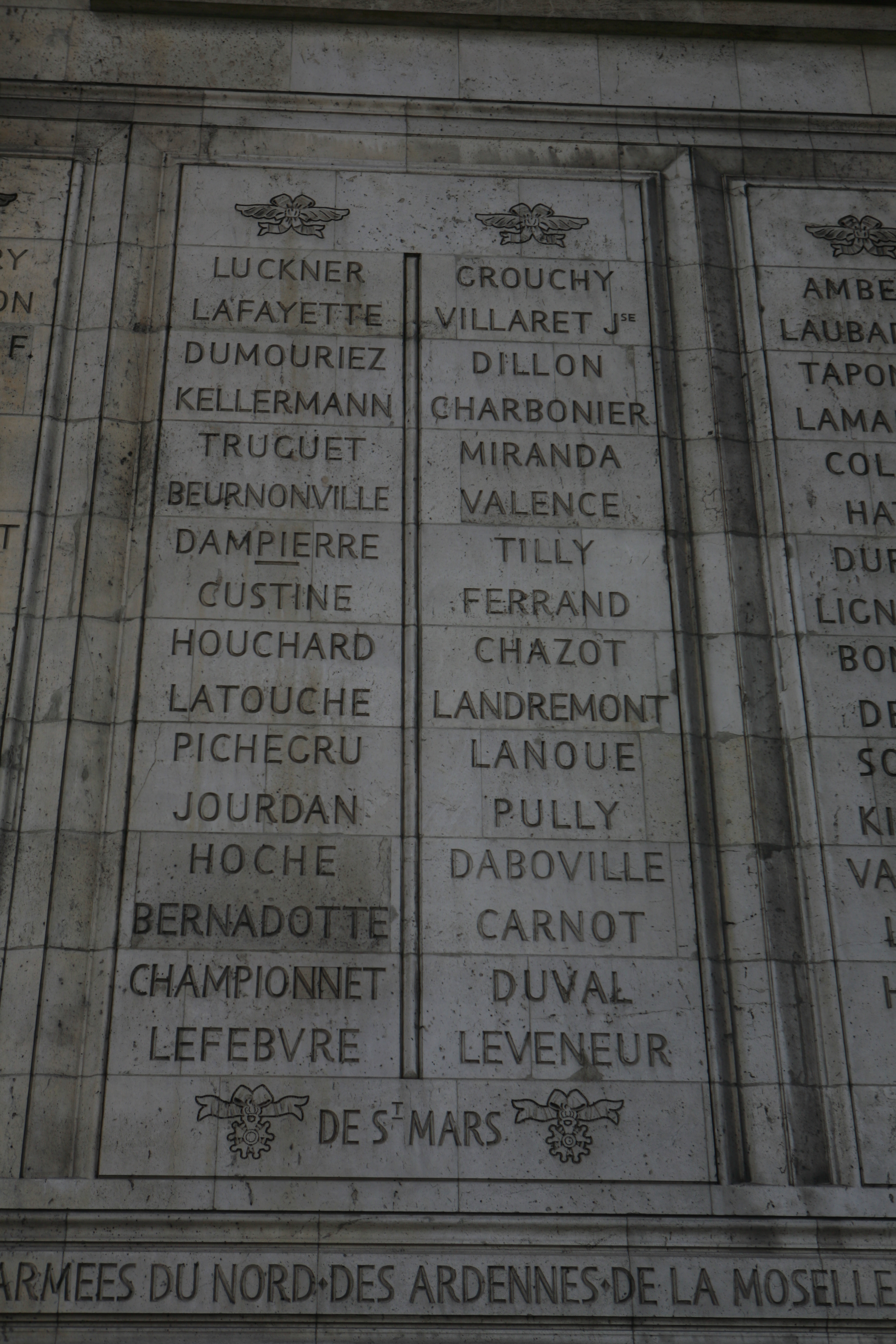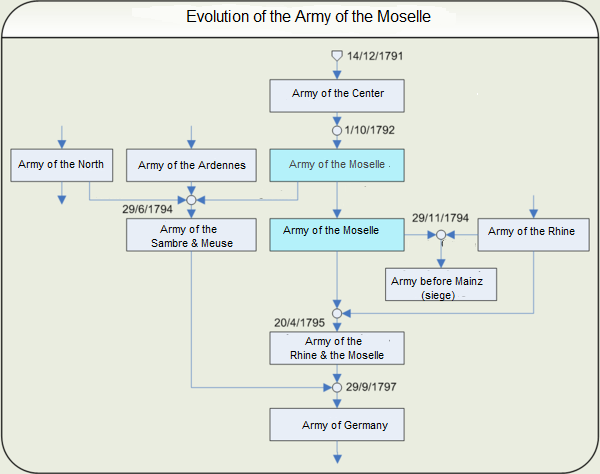|
Charles Leclerc De Landremont
Charles Hyacinthe Leclerc de Landremont (21 August 1739 – 26 September 1818) was the commander in chief of the Rhine in 1793 during the French Revolution. He was also a descendant of the painter Jean LeClerc. Biography His family Leclerc de Landremont was the son of cavalry captain Joseph Leclerc de Landremont and Marie Anne de Morlot. Landremont became a squire in 1789 and a count in 1795. He is the descendant of the painter Jean Le Clerc. Before the French revolution Leclerc first joined the army on 18 April 1759 as a dragoon in the 17th Schomberg regiment before being promoted to cornet on 23 August 1760. He was wounded and taken prisoner after the Battle of Bidingen on 2 March 1761. Upon release he was made second lieutenant on 3 October 1761, before being made first lieutenant in December 1763 and captain on 5 May 1772. On 5 April 1780 he was made captain-commandant of the Schomberg dragoons regimentstationes in Mirecourt. On 16 January 1785 he was made a kn ... [...More Info...] [...Related Items...] OR: [Wikipedia] [Google] [Baidu] |
Captain-commandant
''Captain-commandant'' is a rank currently used in the Belgian Armed Forces and formerly used in the United States Revenue Cutter Service and its successor, the United States Coast Guard. Belgian Armed Forces Captain-commandant is a company grade of commissioned officer rank in the air component, land component, the old Belgian ''Gendarmerie'' and medical component of the Belgian Armed Forces. A ''kapitein-commandant'' (Dutch) or ''capitaine-commandant'' (French) ranks directly above a captain and immediately under a major. Officers of this rank usually serve in staff functions or more rarely as commanders of small units such as squadrons and companies. The insignia are three pips under a narrow stripe for the land component, three blue stripes with navy curl for the air component and three gold stripes with navy curl for the medical component. In the naval component, the rank is called ''luitenant ter zee eerste klasse'' or ''Lieutenant de vaisseau de première classe'' (" ship ... [...More Info...] [...Related Items...] OR: [Wikipedia] [Google] [Baidu] |
Maximilien Robespierre
Maximilien François Marie Isidore de Robespierre (; 6 May 1758 – 28 July 1794) was a French lawyer and statesman who became one of the best-known, influential and controversial figures of the French Revolution. As a member of the Estates-General, the Constituent Assembly, and the Jacobin Club, he campaigned for universal manhood suffrage, the right to vote for people of color, Jews, actors, domestic staff and the abolition of both clerical celibacy and French involvement in the Atlantic slave trade. In 1791, Robespierre was elected as " public accuser" and became an outspoken advocate for male citizens without a political voice, for their unrestricted admission to the National Guard, to public offices, and to the commissioned ranks of the army, for the right to petition and the right to bear arms in self defence. Robespierre played an important part in the agitation which brought about the fall of the French monarchy on 10 August 1792 and the convocation of the Nati ... [...More Info...] [...Related Items...] OR: [Wikipedia] [Google] [Baidu] |
Landau In Der Pfalz
Landau ( pfl, Landach), officially Landau in der Pfalz, is an autonomous (''kreisfrei'') town surrounded by the Südliche Weinstraße ("Southern Wine Route") district of southern Rhineland-Palatinate, Germany. It is a university town (since 1990), a long-standing cultural centre, and a market and shopping town, surrounded by vineyards and wine-growing villages of the Palatinate wine region. Landau lies east of the Palatinate forest, on the German Wine Route. It contains the districts (''Ortsteile'') of Arzheim, Dammheim, Godramstein, Mörlheim, Mörzheim, Nussdorf, Queichheim, and Wollmesheim. History Landau was first mentioned as a settlement in 1106. It was in the possession of the counts of Leiningen-Dagsburg-Landeck, whose arms, differenced by an escutcheon of the Imperial eagle, served as the arms of Landau until 1955. The town was granted a charter in 1274 by King Rudolf I of Germany, who declared the town a Free Imperial Town in 1291; nevertheless Prince-Bishop Emich of ... [...More Info...] [...Related Items...] OR: [Wikipedia] [Google] [Baidu] |
Antoine Guillaume Delmas
Antoine-Guillaume Maurailhac Delmas de La Coste Delmas (3 January 1766 – 30 October 1813) was a French military officer who served in the French Revolutionary Wars and Napoleonic Wars. Delmas was killed at the Battle of Leipzig. cites Delmas was born in Argentat in the Kingdom of France on 3 January 1766. He was wounded at the Battle of Leipzig and later died on 30 October 1813 in Leipzig. His name is inscribed on the east pillar of the Arc de Triomphe. Early Military Experiences In 1781, Delmas became a gentleman cadet in the Touraine infantry regiment. He was commissioned as a sous-lieutenant three years later before being promoted to a lieutenant in 1787. Delmas was dismissed from the regiment for insubordination in 1788. By June 1791, Delmas was a lieutenant in the gendarmerie of his home département of Corrèze. In September of that year he volunteered for the army, becoming a lieutenant colonel of the 1st Battalion of Volunteers of Corrèze. The Revolutionary War ... [...More Info...] [...Related Items...] OR: [Wikipedia] [Google] [Baidu] |
Prison De L'Abbaye
The Prison de l’Abbaye was a Paris prison in use from 1522 to 1854. The final building was built by Christophe Gamard in 1631 and made up of three floors, flanked by two turrets (or more exactly, '' échauguettes''). It was the scene of a portion of the September Massacres, one of the bloodiest episodes of the French Revolution. Twenty-two priests were given summary trials and then killed by mob outside the church. Favier 1988, p. 102. Madame Roland, wife of the Girondin Minister of the Interior Jean-Marie Roland, was interned here on her first arrest in 1793 before being transferred to Sainte Pélagie. History Pre-Revolution It occupied part of the current site of Boulevard Saint-Germain in the SE corner of the enclosure of the Abbey of Saint-Germain-des-Prés. The abbey dated to the earliest era of Paris, when Childebert I (on the site of a temple to Isis or Ceres, according to legend) founded a monastery dedicated to the Holy Cross and to St Vincent of Saragossa, which ... [...More Info...] [...Related Items...] OR: [Wikipedia] [Google] [Baidu] |
Hussar
A hussar ( , ; hu, huszár, pl, husarz, sh, husar / ) was a member of a class of light cavalry, originating in Central Europe during the 15th and 16th centuries. The title and distinctive dress of these horsemen were subsequently widely adopted by light cavalry regiments in European armies in the late 17th and early 18th centuries. By the 19th century, hussars wore jackets decorated with braid and shako or busby hats and they developed a romanticized image of being dashing and adventurous. A small number of modern armies retain the designation of hussars for some armored (tank) units. As well, some modern armies have ceremonial mounted units which wear historical hussar uniforms on parades or to provide a VIP escort to national leaders. Historically, the term derives from the cavalry of late medieval Hungary, under Matthias Corvinus, with mainly Serb warriors. Etymology Etymologists are divided over the derivation of the word ''hussar''. Several alternative theorie ... [...More Info...] [...Related Items...] OR: [Wikipedia] [Google] [Baidu] |
Hussards Du Corps Des Partisans De L'Armée Du Rhin
A hussar ( , ; hu, huszár, pl, husarz, sh, husar / ) was a member of a class of light cavalry, originating in Central Europe during the 15th and 16th centuries. The title and distinctive dress of these horsemen were subsequently widely adopted by light cavalry regiments in European armies in the late 17th and early 18th centuries. By the 19th century, hussars wore jackets decorated with braid and shako or busby hats and they developed a romanticized image of being dashing and adventurous. A small number of modern armies retain the designation of hussars for some armored (tank) units. As well, some modern armies have ceremonial mounted units which wear historical hussar uniforms on parades or to provide a VIP escort to national leaders. Historically, the term derives from the cavalry of late medieval Hungary, under Matthias Corvinus, with mainly Serb warriors. Etymology Etymologists are divided over the derivation of the word ''hussar''. Several alternative the ... [...More Info...] [...Related Items...] OR: [Wikipedia] [Google] [Baidu] |
Alexandre De Beauharnais , a Portuguese hypocoristic of the name "Alexandre"
{{Disambig ...
Alexandre may refer to: * Alexandre (given name) * Alexandre (surname) * Alexandre (film) See also * Alexander * Xano (other) Xano is the name of: * Xano, a Portuguese hypocoristic of the name " Alexandre (other)" * Idálio Alexandre Ferreira (born 1983), Portuguese footballer known as "Xano", currently playing for Sligo Rovers {{hndis ... [...More Info...] [...Related Items...] OR: [Wikipedia] [Google] [Baidu] |
Armée De La Moselle
The Army of the Moselle (''Armée de la Moselle'') was a French Revolutionary Army from 1791 through 1795. It was first known as the ''Army of the Centre'' and it fought at Valmy. In October 1792 it was renamed and subsequently fought at Trier, First Arlon, Biesingen, Kaiserslautern, Froeschwiller and Second Wissembourg. In the spring of 1794 the left wing was detached and fought at Second Arlon, Lambusart and Fleurus before being absorbed by the ''Army of Sambre-et-Meuse''. In late 1794, the army captured Trier and initiated the Siege of Luxembourg. During the siege, the army was discontinued and its divisions were assigned to other armies. History Originally known as the ''Army of the Centre'', it was renamed by decree of the National Convention on 1 October 1792 and kept under that name in the decrees of 1 March and 30 April 1793. By the decree of 29 June 1794 its left wing joined with the ''Army of the Ardennes'' and the right wing of the ''Army of the North'' to form the ... [...More Info...] [...Related Items...] OR: [Wikipedia] [Google] [Baidu] |
Maréchal De Camp
''Maréchal de camp'' (sometimes incorrectly translated as field marshal) was a general officer rank used by the French Army until 1848. The rank originated from the older rank of sergeant major general ( French: ''sergent-major général''). Sergeant major general was third in command in an army, after the general and the lieutenant general. One of his tasks was to dispose the troops on the battlefield. It was also known in the French army as the "battle sergeant" (fr: ''sergent de bataille''). In English-speaking countries, the rank of sergeant major general became known as simply major general. Background and history The ''maréchal de camp'' rank was the junior of the two officer general ranks of the French Army, the senior being lieutenant general. The rank of brigadier was intermediate between those of colonel and ''maréchal de camp'', but was not considered a general officer rank. Nevertheless, when rank insignia were introduced in the 1770s, the brigadier insignia was on ... [...More Info...] [...Related Items...] OR: [Wikipedia] [Google] [Baidu] |






